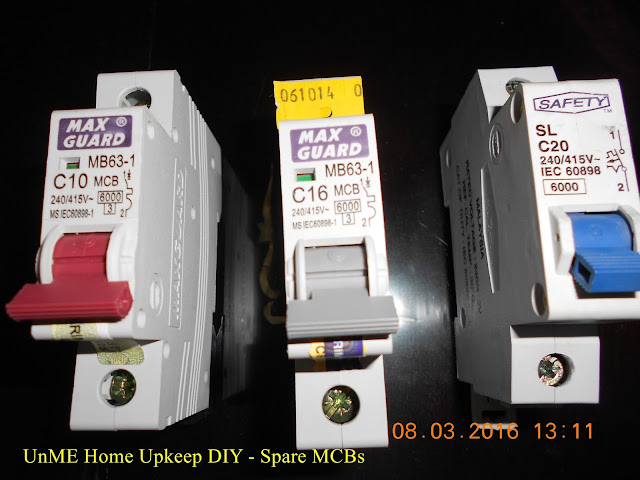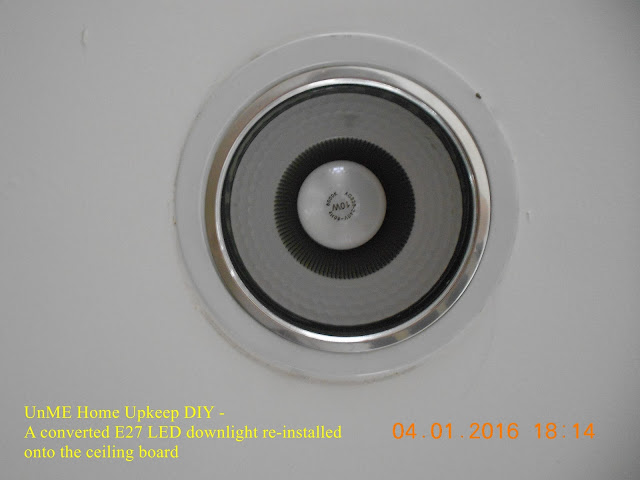All the houses with electricity supply have a small rectangular box near the main door. This box may be made of Plastic with a transparent cover (new MCB box) or a Metal box/Wooden box (old MCB box)
 |
| ELCB |
Inside the box is a row of Main Circuit Breaker (MCB) plus an Earth-Leakage Circuit Breaker(ELCB) and a Main incoming power switch that looks like this .(picture on the right)
 |
| A row of MCB in the box |
On the left is a row of MCB
ELCB is the first level of circuit breaking in the event of power leakage or overloading.
MCB is the second level circuit breaker.
These MCBs do not last a lifetime. After about 10 to 12 years, they will fail and needed replacement.
 |
| Main Switch in the MCB box. |
The ELCB must be tested regularly to ensure proper functioning. The main switch must be turned off before changing or replacing any MCB.
Warning: IF you are not trained, DO NOT meddle with MCB box. This is highly DANGEROUS.
LEAVE THIS JOB TO A QUALIFIED ELECTRICIAN.
I have a friendly electrician who would take care of all the wiring and electrical problems in my house. He has served me well for many years. He would not fail to answer to my electrical problems. Sometimes, the 3-Pin power socket simply has no power supply. The light refused to lighten up with the switch turned on. A certain section of the house has no power supply completely i,e, the Fridge, the light and the fan all not working. And this is usually caused by a tripped or failed MCB. He would obligingly come and changed the failed MCB or simply re-set the tripped MCB. Most of my calls for his services are related to MCB. His charges for materials and labour are reasonable.
To replace a MCB is only a half an hour job, but lately, he spent 1 to 2 hours in the traffic to come and another 1 to 2 hours to go back to his shop. He always come with an assistant electrician. That is about four and a half man-hours per person multiply by two persons is equivalent to nine (9) man-hours for the simple job. That is probably not very profitable to him to charge me RM180 (USD45.00) for replacing one MCB.
He decided to terminate his services and taught me some basic electrician skills and how to replace a MCB.
Henceforth, I have been replacing the MCBs DIY in my home.
Important: MCB, ELCB and Main Switch position are different from normal switch. UP position is power on, DOWN position is power off. (The old level switch in Malaysian home is the opposite. UP position is power OFF and DOWN position is power ON.)
DO NOt touch the LIVE wire to the Main switch, even on OFF position. It still has electricity current.
If the MCB is on down position, the power supply has tripped. This could be due to overloading or power leakage at the device or appliance's point. To test the MCB, switch off all the power points connected to this MCB. Then re-set the MCB by pushing the MCB switch lever upwards. If the switch cannot be pushed to re-set or the lever refused to stay up, this means the MCB has failed,
Once the MCB is successfully re-set or replaced, turn on the power points connected to this MCB one by one.
The power point/appliance/device that caused this MCB to trip is the one with power leakage or overloading. This is not a MCB issue and needs a different solution.
Highly recommended to wear a pair of cotton gloves and rubber shoes as a safety precaution while working on MCB box.
Replace the MCB with the same power rating only. MCBs for
home use come in C10, C16, C20 and C32. The number denotes the amperes of electricity. That is 10 amps to 32 amps range only.
There are various brands of MCB in the market. The more reliable and reputable brand are HAGER. GE and ABB. The common local Malaysian brand are MAXGUARD and SAFETY. The price difference between European brand and Malaysian brand MCB is great. HAGER cost about RM8.50(USD2.15) a piece. The Malaysian brand MAXGUARD is only RM4.50 (USD1.15) per piece.
To replace a MCB, the following procedures must be strictly observed:-
1. Push the test button of the ELCB, The ELCB switch lever will drop down.
2. Push to the Main switch lever in the MCB box downwards to disconnect power supply to all the MCBs.
3. Use a test pen to test all the MCB wire connections to ensure that there is no electric current flowing. Only after all the tests have passed, then only start to dislodge the damaged/failed MCB.
4. Push the plastic clip at the bottom of the failed MCB downwards to unlock from the bar.
5. Push the MCB upwards to dislodge completely from the bar.
 6. Unscrew and remove the wire at top of the MCB.
6. Unscrew and remove the wire at top of the MCB.7. Re-connect the same wire to a new MCB of the same rating..
8. Insert the new MCB from the top of the bar. Ensure the hook of the MCB is hanging on the bar.
9. Push the MCB inwards toward the bar and lock securely by pushing the plastic clip upwards.
 10 Ensure the MCB is properly secured to the bar by pulling outwards to test it.
10 Ensure the MCB is properly secured to the bar by pulling outwards to test it.To restore power to the MCB, turn on the ELCB first, follow with the Main switch.
It is advisable to turn off all the MCB before restoring power. After the main switch lever is put to ON position, switch ON the MCB one by one.
I dismantled this failed MCB to find out the cause of the failure.
 |
| This is a badly burnt MCB |
I always keep a few MCB of C10. C16 and C20 as spares for replacement whenever required, so that I need not run to the electrical supply shop frequently. My MCB box is 13 years old now and prone to MCB failure.
 |
| The Most Commonly Used MCB in home are C10, C16 and C20 |
DO NOT attempt to change the MCB DIY, without proper training from a qualified Electrician



















